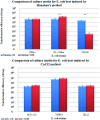A comparison and optimization of methods and factors affecting the transformation of Escherichia coli
- PMID: 24229075
- PMCID: PMC3860579
- DOI: 10.1042/BSR20130098
A comparison and optimization of methods and factors affecting the transformation of Escherichia coli
Abstract
DNA manipulation routinely requires competent bacteria that can be made using one of numerous methods. To determine the best methods, we compared four commonly used chemical methods (DMSO, MgCl2-CaCl2, CaCl2 and Hanahan's methods) on frequently used Escherichia coli (E. coli) strains: DH5α, XL-1 Blue, SCS110, JM109, TOP10 and BL21-(DE3)-PLysS. Hanahan's method was found to be most effective for DH5α, XL-1 Blue and JM109 strains (P<0.05), whilst the CaCl2 method was best for SCS110, TOP10 and BL21 strains (P<0.05). The use of SOB (super optimal broth) over LB [Luria-Bertani (broth)] growth media was found to enhance the competency of XL-1 Blue (P<0.05), dampened JM109's competency (P<0.05), and had no effect on the other strains (P>0.05). We found no significant differences between using 45 or 90 s heat shock across all the six strains (P>0.05). Through further optimization by means of concentrating the aliquots, we were able to get further increases in transformation efficiencies. Based on the optimized parameters and methods, these common laboratory E. coli strains attained high levels of TrE (transformation efficiency), thus facilitating the production of highly efficient and cost-effective competent bacteria.
Figures




Similar articles
-
The Hanahan Method for Preparation and Transformation of Competent Escherichia coli: High-Efficiency Transformation.Cold Spring Harb Protoc. 2018 Mar 1;2018(3). doi: 10.1101/pdb.prot101188. Cold Spring Harb Protoc. 2018. PMID: 29496820
-
Role of cspA on the Preparation of Escherichia coli Competent Cells by Calcium Chloride Method.J Basic Microbiol. 2024 Aug;64(8):e2400113. doi: 10.1002/jobm.202400113. Epub 2024 Jun 25. J Basic Microbiol. 2024. PMID: 38924123
-
Vibration and glycerol-mediated plasmid DNA transformation for Escherichia coli.FEMS Microbiol Lett. 2013 Nov;348(1):74-8. doi: 10.1111/1574-6968.12247. Epub 2013 Sep 19. FEMS Microbiol Lett. 2013. PMID: 24004211
-
Analysis of comparative efficiencies of different transformation methods of E. coli using two common plasmid vectors.Indian J Biochem Biophys. 2009 Oct;46(5):395-400. Indian J Biochem Biophys. 2009. PMID: 20027870
-
Plasmid uptake by bacteria: a comparison of methods and efficiencies.Appl Microbiol Biotechnol. 2009 Jul;83(5):791-8. doi: 10.1007/s00253-009-2042-4. Epub 2009 May 27. Appl Microbiol Biotechnol. 2009. PMID: 19471921 Review.
Cited by
-
Spontaneous Mutations in HIV-1 Gag, Protease, RT p66 in the First Replication Cycle and How They Appear: Insights from an In Vitro Assay on Mutation Rates and Types.Int J Mol Sci. 2020 Dec 31;22(1):370. doi: 10.3390/ijms22010370. Int J Mol Sci. 2020. PMID: 33396460 Free PMC article.
-
Solar photon-Fenton process eliminates free plasmid DNA harboring antimicrobial resistance genes from wastewater.J Environ Manage. 2021 May 1;285:112204. doi: 10.1016/j.jenvman.2021.112204. Epub 2021 Feb 19. J Environ Manage. 2021. PMID: 33618138 Free PMC article.
-
A bispecific, crosslinking lectibody activates cytotoxic T cells and induces cancer cell death.J Transl Med. 2022 Dec 9;20(1):578. doi: 10.1186/s12967-022-03794-w. J Transl Med. 2022. PMID: 36494671 Free PMC article.
-
Cloning and characterization of norbelladine synthase catalyzing the first committed reaction in Amaryllidaceae alkaloid biosynthesis.BMC Plant Biol. 2018 Dec 7;18(1):338. doi: 10.1186/s12870-018-1570-4. BMC Plant Biol. 2018. PMID: 30526483 Free PMC article.
-
Identification and characterization of a novel 6'-N-aminoglycoside acetyltransferase AAC(6')-Va from a clinical isolate of Aeromonas hydrophila.Front Microbiol. 2023 Oct 18;14:1229593. doi: 10.3389/fmicb.2023.1229593. eCollection 2023. Front Microbiol. 2023. PMID: 37920263 Free PMC article.
References
-
- Mandel M., Higa A. Calcium-dependent bacteriophage DNA infection. J. Mol. Biol. 1970;53:159–162. - PubMed
Publication types
MeSH terms
Substances
LinkOut - more resources
Full Text Sources
Other Literature Sources

